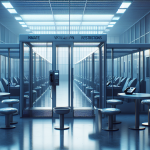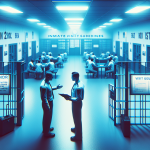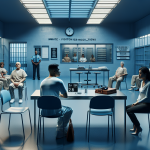Visiting an incarcerated loved one can be intimidating and difficult to navigate. California Rehabilitation Center (CRC) understands the importance of these visits and provides an Inmate Visitation Overview to help families and friends alike, be able to have visits with their loved ones.
Inmates in CRC are allowed to have up to four visitors per visit, and each visitor must register at least 24 hours prior to the visit. Each visitor must fill out an application with basic information such as name, address, and photo ID. Minor visitors will not be allowed unless accompanied by an adult. All visitors must wear appropriate attire and present a valid ID upon entry. For safety and security, visitors will need to be screened and will be subject to search.
CRC allows multiple ways to manage inmate visits. Visitors can set up a visit by calling the facility, going online, or signing up for the convenient kiosk available inside the facility. Those who utilize the kiosk machines will also be able to view a list of inmates available for visits and check the availability of visits. Scheduling visits in advance is recommended due to availability fill up quickly.
The CRC Inmate Visitation Overview caters to both visitors and inmates with the utmost respect and care. CRC offers video and in-person visitations, allowing inmates to stay connected with their loved ones, while also being closely monitored for a safe and secure experience. Visitation hours change based on the location and type of visitation and all visits must follow the same rules as well as the terms and conditions.
Any violators of these guidelines will be subject to immediate termination of visitation. The CRC Inmate Visitation Overview serves as the ultimate guide for families and friends of inmates to understand their rights and book a safe, secure, and fulfilling visit. With the CRC Inmate Visitation Overview, visitors can experience peace of mind knowing that the well-being of theiriterable family member is always a priority.
California Rehabilitation Center (CRC) – Overview and Information
California Rehabilitation Center (CRC) is a California-based long-term residential treatment facility for individuals who suffer from severe and persistent mental illness. It is one of the largest and most respected programs for individuals with serious mental health needs in the nation. CRC has earned national and international recognition for its comprehensive, integrated, and holistic approach to treatment.
CRC offers a wide range of treatment options, which include individual psychotherapy, group therapy, medication management, and recreational therapy. At the core of the program is a cognitive behavioral therapy approach that helps individuals to identify and modify behaviors that interfere with their functioning. This approach also helps individuals to develop healthy coping skills and identify a personal sense of control, problem solve, become assertive and successful in the community, and prevent relapse.
CRC also provides services that focus on relapse prevention and social reintegration programming. This includes educational classes, vocational services, and assistance with accessing benefits. CRC also offers a wide array of social activities, such as activities of daily living and community outings. This allows individuals to develop self-confidence while gaining proficiency in independent living skills.
Finally, CRC has a commitment to providing a supportive and accepting environment. Staff members use a strengths-based approach to treatment, helping individuals to understand their own strengths while also promoting recovery-oriented thinking and practices.
CRC’s ultimate goal is to help individuals to move beyond their mental illness, and achieve recovery and independent functioning. The facility offers the highest quality of care, while empowering individuals to mediate their own recovery. With the help of CRC’s professional and dedicated staff, those individuals affected by mental illness have hope to achieve a full and meaningful life.
California Rehabilitation Center (CRC) – Classes, Services, and Programs
The California Rehabilitation Center (CRC), located in Norco, CA, is a state-run correctional facility for offenders who have been sentenced to serve their time at an out-of-state prison. At CRC, inmates are offered a variety of classes, services, and programs designed to help them reenter society.
Classes at the CRC include classes designed to help inmates acquire the basic knowledge and skills necessary to function as an employee and productive citizen once they are released. Courses range from classes that teach life skills such as time management and budgeting, to classes designed to help inmates obtain educational qualifications or vocational certifications. Additionally, inmates are required to complete a number of courses that focus on anger management, substance abuse, and other topics.
Services offered by the CRC include job-readiness and job skill development, substance abuse treatment, mental health services, and access to life skills and social skills training. Inmates can also participate in educational and recreational activities, including art classes and competitive sports leagues.
Several programs are available to inmates at CRC, including job-training programs that can help released inmates find employment and stay employed in the community. In addition, the CRC offers programs designed to provide access to credit and financial counseling, and substance abuse treatment. Additionally, the CRC has programs in place to help inmates transition back into society, such as family support and reunification services and programs designed to help released prisoners obtain stable housing and transportation.
At the CRC, inmates are provided with the necessary resources to ensure successful reintegration back into the community. The facility’s classes, services, and programs are designed to provide inmates with the skills and support necessary to lead productive and meaningful lives in society upon their release.
Inmate visiting application in California Rehabilitation Center (CRC)
Inmate Visiting Application in California Rehabilitation Center (CRC):
If you would like to visit an inmate at the California Rehabilitation Center (CRC), you will need to complete and submit an Inmate Visiting Application. The application can be found online or at the institution itself.
To begin the application, you will need to enter the first and last name of the inmate and their CSC number, which is provided by the facility. You will also need to provide contact information which includes your full name, address, phone number, and email.
Once the application is filled out, you will need to print the form and take it up to the Inmate Planning Office. At the office, you will need to check in with the Officer and provide your driver’s license or other valid form of identification.
Once you have been approved for visitation, a visiting schedule will be set up and you can begin visiting the inmate. The appointment will last up to two hours, and visitors are subject to searches upon entry.
Visitors under the age of 18 must be accompanied by an adult. Any gifts brought for the inmate that are not allowed in the facility must be left with the Officer at the entrance. Additionally, the Officer at the entrance will be able to provide additional guidelines and regulations for prisoner visitation.
It is important to remember that there may be additional visiting policies that may be specific to the facility. Visiting regulations should always be checked before scheduling a visit to ensure that visiting rights are not violated.
California Rehabilitation Center (CRC): Frequently Asked Questions and Answers
1. What is California Rehabilitation Center (CRC)?
The California Rehabilitation Center (CRC) is a state prison located in Norco, California. It is primarily a reception center that provides assessment and evaluation for most incoming male state prisoners in the California Department of Corrections and Rehabilitation (CDCR).
2. What kinds of services does CRC offer?
CRC offers a range of services, including a substance abuse program, mental health services, medical and dental care, educational and vocational training, and support activities for successful re-entry into society.
3. Who is eligible for CRC services?
Individuals who have been sentenced to serve time in state prison are eligible for services offered by CRC.
4. How long does CRC programming last?
The length of the program depends on individual assessment and the needs of the offender. In general, CRC programming usually lasts from 6 to 18 months.
5. What kind of programming and services are offered at CRC?
CRC offers a range of educational and vocational classes, such as computer skills and job and interview skills. It also provides cognitive and self-awareness classes, which help inmates better understand the criminal justice system and how to live a healthier life outside of prison. In addition, CRC offers various therapeutic and rehabilitative programming, such as substance abuse and anger management classes, as well as life-skills training.
6. What happens after someone completes the CRC program?
Upon successful completion of a CRC program, inmates are typically sent to a lower-security facility to serve out the remainder of their sentence. From there they are eligible for parole and will participate in additional reentry services, such as job training and substance abuse programs.
7. Who is responsible for monitoring CRC programming?
The Office of Correctional Education (OCE) is responsible for the quality of all educational and vocational programming offered at CRC. All CRC programs are overseen by the CDCR to ensure that all educational and therapeutic programming is up to date and meeting the needs of incarcerated individuals.
8. Does CRC offer visitation opportunities?
Yes, CRC offers visitation opportunities to family and friends. Visits must be arranged in advance, and all visitors must adhere to CDCR policies and regulations.






